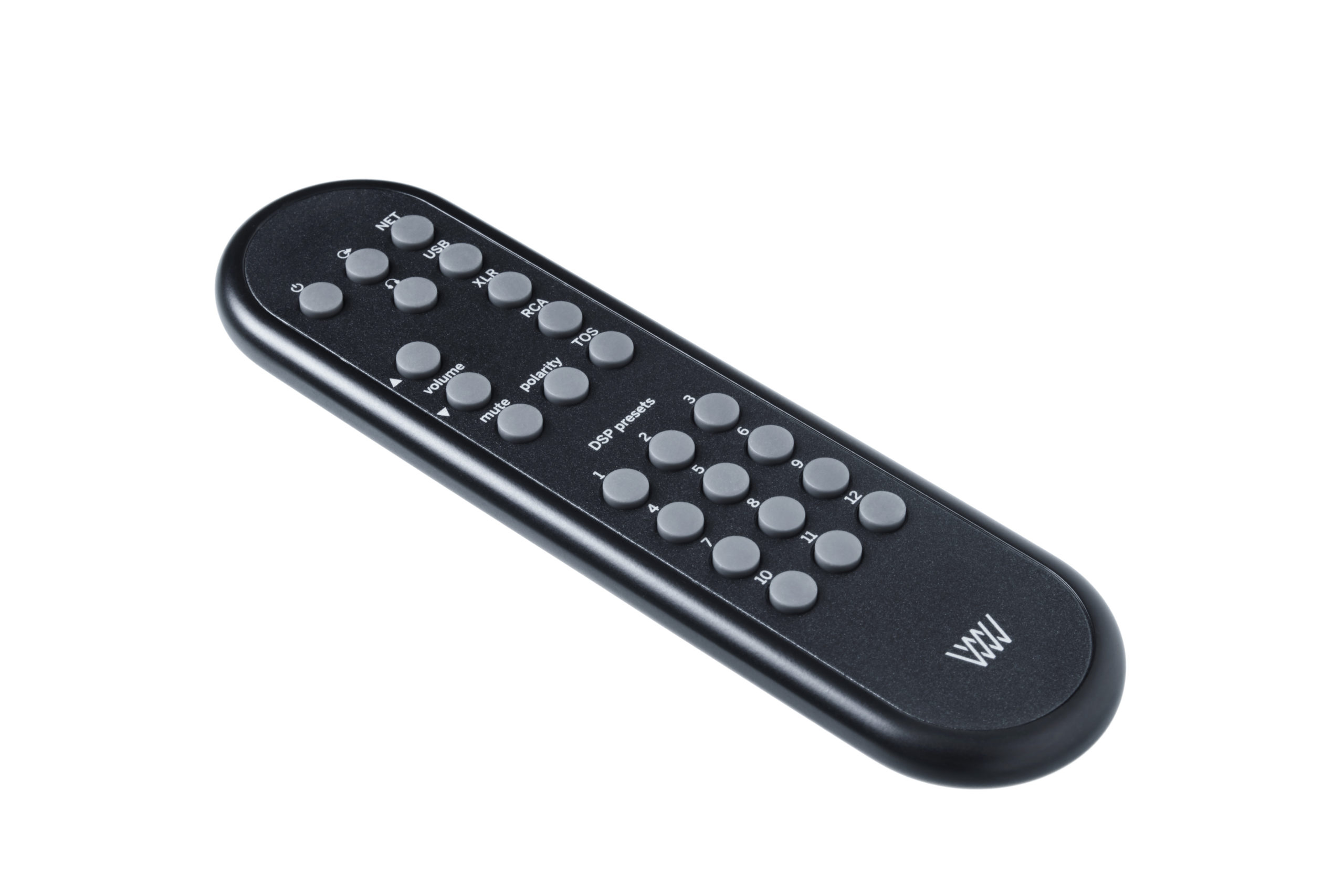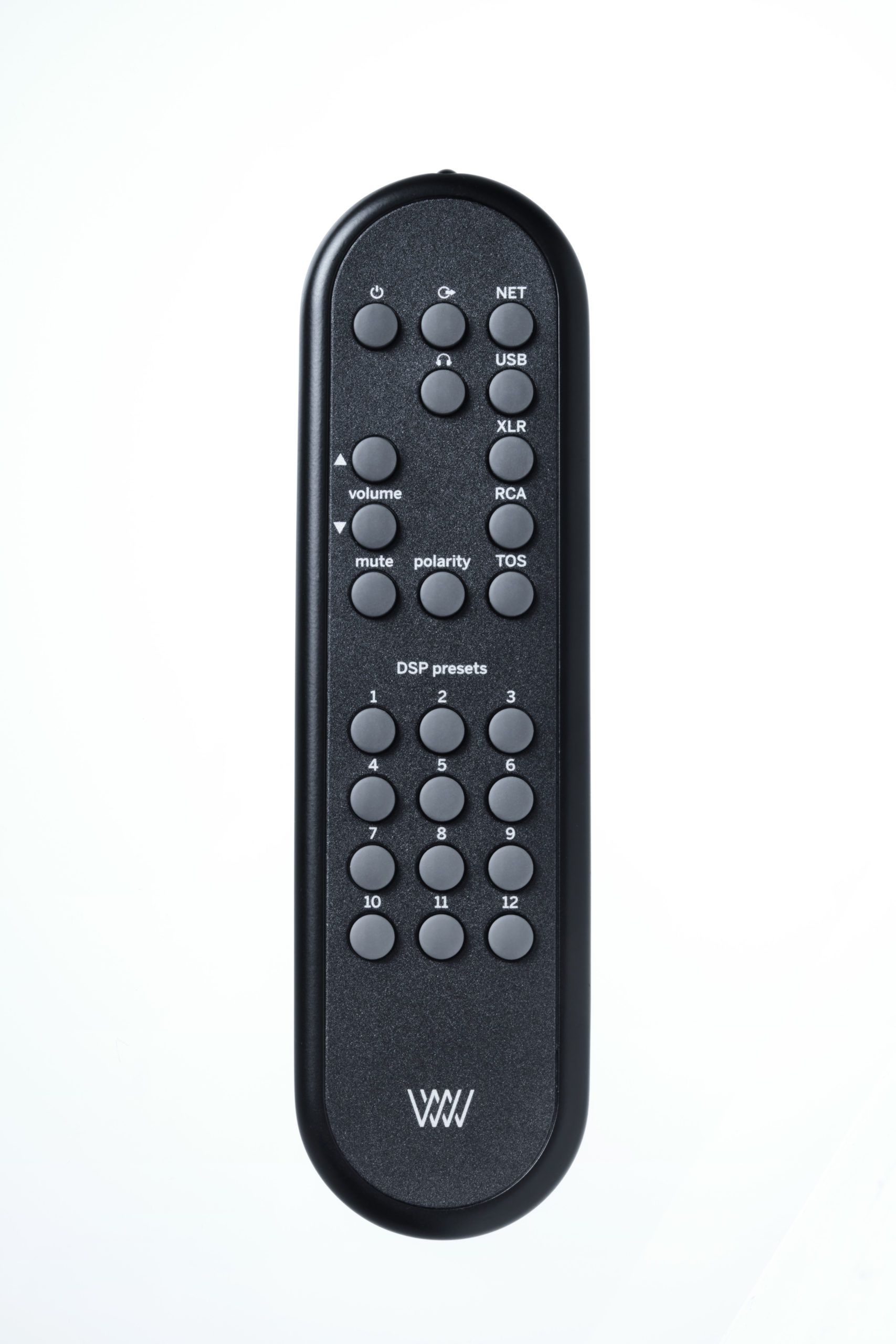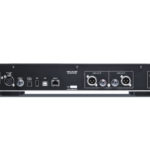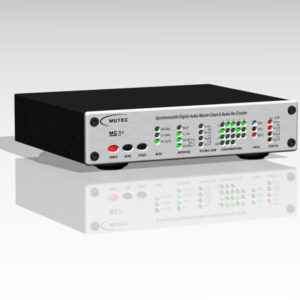THE DAC 502 MK2 USES A LARGER FRAME BUT ELSE SPORTS THE SAME FEATURES AS THE DAC501 MK2. EXCEPT FOR AN AN ADDITIONAL 4 PIN HEADPHONE SOCKET AT THE BACK OF THE UNIT.
With the DAC50x MK2 we are creating a new paradigm for what used to be a black box device. A typical D/A Converter is a “set and forget” device. Not so with the DAC50x MK2. It adds a number of interesting signal processing features and sports a variety of digital inputs. Balanced, unbalanced and headphone outputs are provided.
Weiss Engineering has a 30 year history in D/A Converter design. In that time span we have learned a thing or two about converter design. The DAC50x MK2 is the essence of our experiences.
DAC501-4CH and DAC502 MK2 are Roon Ready.
Main Features
Mechanics
The DAC50x MK2 uses a stainless steel chassis with a solid 10 mm aluminium front plate.
Power Supply
A powerful non-switching power supply is used. All sensitive voltages have their own regulators which are separated between left and right channels. The result is an analog output free of “digital noise” and channel crosstalk. The power switch activates a semiconductor relay which only switches on or off at zero crossings of the mains voltage. This assures a glitch free power switching. The two mains transformers are toroidal types. Mains voltage selection is done automatically by measuring the mains voltage before power is applied to the rest of the electronics.
Synchronization
An internal high precision / low jitter clock generator is responsible for clocking the D/A converter section. The sampling frequency of that generator is fixed at about 195kHz. The input signals are converted to the 195kHz sampling frequency for optimal signal quality. This scheme also helps significantly in reducing any jitter related effects. All standard sampling frequencies up to 384 kHz plus DSD x64 and x128 are supported.
Digital Inputs
There are a total of five inputs:
- AES/EBU or S/PDIF via XLR, Toslink and RCA sockets
- UPnP / DLNA via Ethernet
- USB
- Roon Ready
Accepted formats: PCM 44.1kHz up to 384 kHz, DSD 64x / 128x.
Future formats can be accommodated for via software updates.
Signal Processing
The DAC50x MK2 has a digital signal processing chip built in (DSP).
The following DSP algorithms are currently implemented:
- Room Equalizer – to suppress room modes for a decent bass reproduction.
- Creative Equalizer – a tone control with low boost/cut, high boost/cut and mid boost/cut. Very useful to correct those recordings which do not quite sound right.
- De-Essing – the automatic removal of overly bright sibilances from human voices. The sibilance effect can be more or less pronounced depending on your speakers or room acoustics.
- Constant Volume – adjusts the audio volume (loudness) to a constant value across all tracks played. Useful for “party mode” when the volume control should stay untouched.
- Vinyl Emulation – get that special sonic character of a record player based playback chain. We also employ an emulation of the DMM-CD procedure offered by the Stockfisch label.
- Crosstalk Cancelling (XTC) – for the playback of dummy head recordings or live recordings via speakers for an incredible live sensation. Dummy head recordings usually are listened to via headphones because they only work properly if the left channel goes to the left ear only and the right channel to the right ear only. With speakers this is difficult to achive as the left channel goes to the left and the right ear. But with some clever signal processing of the speaker channels is is possible to suppress the crosstalk, i.e. the audio going from the left speaker to the right ear and vice versa. If that works properly then the recording sounds as if one would be in the space where the recording has taken place. All the reverberation and 3D representation of the sound sources is there.(For speaker based playback only.)
- Loudness Control – a listening volume dependent equalization of the audio.
- Headphone Equalizer – to adapt any headphone to the listener’s ears in terms of frequency response.
- Crossfeed – to emulate a speaker based playback impression on headphones.
Converters
Four of the latest 32 bit D/A Converter chips are used. Four D/A conversion channels are used per audio channel, resulting in exceptional performance specifications.
Analog Outputs
- Line out unbalanced on RCA connector.
- Line out balanced on XLR connector.
- Headphone out on 1/4″ Jack Analogue.
- For the DAC502: Addtional headphone output on a 4 pin XLR connector.
Discrete output stages for both line and headphone outputs are employed.
The output levels can be set in a coarse manner with 4 steps to adapt for the amplifier or headphone connected. The levels can be set independently for line and headphone outputs.
No sound degrading servo mechanisms are used.
Front Panel Controls
- A rotary encoder knob for changing parameters and for powering the unit on/off.
- A touch screen colour LCD display.
- An 1/4 inch headphone socket.
- An IR receiver.
Back Panel Elements
- Analog outputs on XLR and RCA connectors.
- Digital inputs on XLR, RCA, TOSLINK, USB, Ethernet connectors.
- USB type A connector for various applications.
- Mains connector with fuses.
IR Remote Control
Allows to control several functions of the DAC50x-4CH, namely:
- The input selected for conversion.
- The output type, level, muting, absolute polarity.
- Power on/off.
- DSP presets.
Web Interface
The DAC50x-4CH has a web interface for configuring it via a web browser. The following functions are accessible via the web interface:
- Volume and Balance controls.
- Input selection.
- Output type.
- DSP algorithms configuration.
- DSP snapshots configuration.
Awards
- Product of the Year Awards!
- AudioArt – DAC Products of the Year 2020
- SoundStage Pioneering Design Achievement
- 26th Guangzhou AV fair – Best DAC
- MyHiend – Best Innovation Award
- Audiophile/Videophile – Product of the Year
- HiFiReview – Product of the Year
Technical Data
Power
Mains voltage: 100…120 V or 200…240 V, automatic voltage selection
Fuse rating: 500 mA slow blow at 100…120 V, 250 mA slow blow at 200…240 V
Power consumption: 25 VA max.
Power consumption in standby: 2.2 VA max.
Size DAC501 MK2
Depth: 30 cm
Width: 18,8 cm
Height: 6,6 cm
Height with feet: 7,2 cm
Size DAC502 MK2
Depth: 30 cm
Width: 45 cm
Height: 6,6 cm
Height including feet: 7,4 cm
Size Remote
Depth: 2,1 cm
Width: 4,5 cm
Height: 16,6 cm
Available Color
Silver, Black
Digital Inputs
(1) XLR connector
(1) RCA connector
(1) TOSLINK connector (optical)
(1) USB type B connector
(1) RJ45 Ethernet connector
All inputs accept professional or consumer standard , i.e. accept AES/EBU or S/PDIF signals .
Sampling frequencies: 44.1 kHz, 48 kHz, 88.2 kHz, 96 kHz, 176.4 kHz or 192 kHz on any of the inputs.
USB and Ethernet also support 352.8 kHz, 384 kHz, DSD64 and DSD128.
Maximum input word-length: 24 / 32 Bits.
Digital Outputs
none
Analog Outputs
(2) XLR connectors (hot on pin 2), short circuit proof output circuitry, DC coupled, low output impedance
(2) RCA connectors, short circuit proof output circuitry, DC coupled, low output impedance
(1) 6.3mm Jack socket for headphones, DC coupled, low output impedance
At the DAC502 only: (1) 4 pin XLR socket for headphones, DC coupled, low output impedance.
The output level is selectable via the LCD menu or the web interface; four settings are provided as shown below:
XLR Output with a 0 dBFS sine wave input:
0 dB setting: 6.8 Vrms +18.9 dBu
-10 dB setting:
2.2 Vrms +8.9 dBu
-20 dB setting: 0.68 Vrms -1.1 dBu
-30 dB setting: 0.22 Vrms -11.1 dBu
These levels are achieved with a 0.0 dB setting for the level control on the LCD screen.
Suggested subsequent amplifier input impedances:
0 dB setting: 900 Ω or higher
-10 dB setting: 100 Ω or higher
-20 dB setting: 60 Ω or higher
-30 dB setting: 60 Ω or higher
RCA Output with a 0 dBFS sine wave input:
0 dB setting: 3.4 Vrms +12.9 dBu
-10 dB setting:
1.1 Vrms +2.9 dBu
-20 dB setting: 0.34 Vrms -7.1 dBu
-30 dB setting: 0.11 Vrms -17.1 dBu
These levels are achieved with a 0.0 dB setting for the level control on the LCD screen.
Suggested subsequent amplifier input impedances:
0 dB setting: 450 Ω or higher
-10 dB setting: 50 Ω or higher
-20 dB setting: 30 Ω or higher
-30 dB setting: 30 Ω or higher
Headphone Output:
(1) stereo 1/4-inch jack connector, DC coupled. The output level is selectable via the LCD menu; four level settings are provided as shown below:
Headphone output with a 0 dBFS sine wave input:
0 dB setting: 6.8 Vrms +18.9 dBu
-10 dB setting:
2.2 Vrms +8.9 dBu
-20 dB setting: 0.68 Vrms -1.1 dBu
-30 dB setting: 0.22 Vrms -11.1 dBu

These levels are achieved with a 0.0 dB setting for the level control on the LCD screen.
Suggested headphone impedances:
0 dB setting: 200 Ω or higher
-10 dB setting: 30 Ω or higher
-20 dB setting: 10 Ω or higher
-30 dB setting: 4 Ω or higher
The same parameters apply to the 4 pin headphone output of the DAC502 as well.
Synchronization
Via the input signal in case of the AES/EBU and S/PDIF inputs. Via the internal oscillator in the case of USB and Ethernet inputs
D/A Converter chip
Over-sampling multi-bit sigma-delta converter
Two converters per audio channel
Measurements Main Output
The measurements below have been taken at the following conditions (unless noted otherwise): 1 kHz measurement frequency, maximum selectable output level, 192 kHz sampling frequency (Fs), 22 kHz measurement bandwidth, unweighted, 0 dBr equals the output level at 0 dBFS input.
Frequency Response:
Fs = 44.1 kHz, 0 Hz…20 kHz: within ±0.25 dB
Fs = 88.2 kHz, 0 Hz…20 kHz: within ±0.25 dB
Fs = 88.2 kHz, 0 Hz…40 kHz: within ±0.8 dB
Fs = 176.4 kHz, 0 Hz…20 kHz: within ±0.25 dB
Fs = 176.4 kHz, 0 Hz…40 kHz: within ±0.8 dB
Fs = 176.4 kHz, 0 Hz…80 kHz: within ±2.5 dB
Total Harmonic Distortion plus Noise (THD+N):
-111 dBr (0.0003 %) at −3 dBFS input level
-125 dBr (0.000056 %) at −40 dBFS input level
-125 dBr (0.000056 %) at −70 dBFS input level
Linearity:
At 0 dBFS to −120 dBFS input level: less than ±0.2 dB deviation from ideal
Spurious components (including harmonics):
At 0 dBFS input level, maximum output level, 1 kHz, all components at less than −110 dB
At 0 dBFS input level, maximum output level, 4 kHz, all components at less than −110 dB
Crosstalk:
Better than 110 dB, 20 Hz…20 kHz
Interchannel Phase Response:
±0.3° 20 Hz…20 kHz
±0.6° 20 Hz…80 kHz
Measurements Headphone Output
The measurements below have been taken at the following conditions (unless noted otherwise): 1 kHz measurement frequency, maximum selectable output level, 192 kHz sampling frequency (Fs), 22 kHz measurement bandwidth, unweighted, 0 dBr equals the output level at 0 dBFS input.
Frequency Response:
Fs = 44.1kHz, 0 Hz…20 kHz: within ±0.25 dB
Fs = 88.2kHz, 0 Hz…20 kHz: within ±0.25 dB
Fs = 88.2kHz, 0 Hz…40 kHz: within ±0.8 dB
Fs = 176.4 kHz, 0 Hz…20 kHz: within ±0.25 dB
Fs = 176.4 kHz, 0 Hz…40 kHz: within ±0.8 dB
Fs = 176.4 kHz, 0 Hz…80 kHz: within ±2.5 dB
Total Harmonic Distortion plus Noise (THD+N):
−112 dBr (0.00025 %) at −3 dBFS input level
−121 dBr (0.000089 %) at −40 dBFS input level
−121 dBr (0.000089 %) at −70 dBFS input level
Linearity:
At 0 dBFS to −120 dBFS input level: less than ±0.4 dB deviation from ideal
Spurious Components (including Harmonics):
At 0 dBFS input level, maximum output level, 100 kΩ load, 1 kHz, all components at less than −110 dB
At 0 dBFS input level, maximum output level, 600 Ω load, 1 kHz, all components at less than −110 dB
At 0 dBFS input level, maximum output level, 300 Ω load, 1 kHz, all components at less than −110 dB
At 0 dBFS input level, maximum output level, 100 kΩ load, 4 kHz, all components at less than −110 dB
At 0 dBFS input level, maximum output level, 600 Ω load, 4 kHz, all components at less than −110 dB
At 0 dBFS input level, maximum output level, 300 Ω load, 4 kHz, all components at less than −110 dB
Crosstalk:
Better than 105 dB, 20 Hz…20 kHz
Interchannel Phase Response:
±0.2° 20 Hz…20 kHz
±0.5° 20 Hz…80 kHz
































